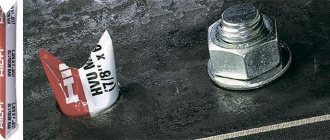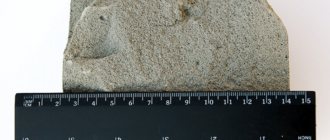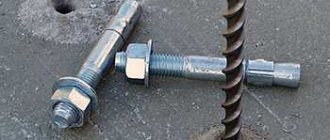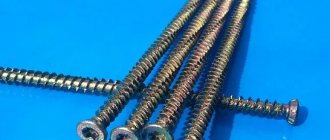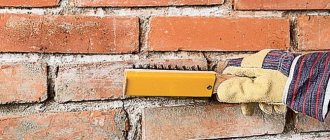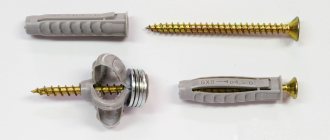Key Features
Just 20 years ago, liquid anchor was considered an expensive novelty and was used only as an experiment. Since then, the composition and technology of such anchors have stepped forward, which has made this type of fasteners preferable and cheaper when working with complex materials. Quite often this technology is called adhesive dowel.
The chemical anchor is a synthetic two-component resin for connecting and fixing metal products to the base material. This solution appeared on the market relatively recently, but due to its outstanding characteristics it has won consumer recognition. Chemical anchors are most often used when conventional plastic or metal anchors are unable to hold the structure in place.
Liquid anchor has found its use when working with:
- dense concrete;
- porous materials;
hollow building products.
As for porous materials, expanded clay concrete, cellular concrete, sandstone and limestone should also be highlighted among them. If we are talking about construction products, then in this case we need to mention porous ceramics and bricks.
About the composition
Chemical anchors used in the installation of any structures have a composition that we will discuss below.
So, the composition:
- Special glue.
- Metal fastening insert. It is a bushing that has a thread, a stud and a reinforcing rod inside. The insert is made of galvanized or stainless steel.
The adhesive composition itself must be very strong. After all, chemical anchors are used when working with concrete elements, for example. Naturally, the fixing force of the anchors must be significant.
As a rule, the adhesive composition is prepared using the following components:
- Artificial resins based on polyurethane, polyester or acrylic.
- Quartz sand and cement-type binders. They are used as fillers and additionally provide the strength characteristics of the adhesive.
- Hardener. It is necessary for the glue to dry quickly and retain its properties for a long time.
Now that everything is clear about the composition of chemical anchors, it’s worth understanding what types of anchors there are.
Types of liquid anchors
Liquid anchor is offered for sale in two varieties, including ampoule and injection. The first ones come in one- and two-component compositions. As for injectables, they are sold in tubes and cartridges, and their second name is capsule.
Ampoule liquid anchors are represented by glass cylinders, inside of which there is a resin, which hardens when exposed to air. Before using this solution, holes are drilled in the material into which an ampoule with polyester resin is placed. At the next stage, an anchor in the form of a metal pin is screwed into it. The ampoule breaks, releasing the glue, which sets. The pieces of glass act as reinforcement.
Liquid chemical anchor can be mixed with styrene, and the setting will depend on the air temperature and the grade of the material. Injection anchors are used as follows. At the first stage, a hole is made in the concrete, the internal cavity of which is well cleaned. The glue is squeezed out there and the fastening element is inserted. During the hardening process, the composition fills all pores and irregularities. This technique is more suitable for empty construction materials.
Features of the liquid anchor HIT-RE 100 from the manufacturer Hilti
Liquid anchor "Hilti" is very popular among consumers today. Among other varieties, you can find HIT-RE 100 on sale. This epoxy adhesive composition is intended for installing reinforcement and anchors in concrete. The base is epoxy glue. This mixture can be transported and stored at temperatures ranging from +5 to +25 °C. The anchor can be used in a fairly wide temperature range from -40 to +70 °C.
One of the main advantages of the anchor is the absence of the risk of cracks. The curing time of the mixture is extended, which allows elements to be adjusted during installation. The Hilti liquid anchor, the method of application of which will be mentioned below, is suitable for use indoors and outdoors in conjunction with material in different states, namely:
- damp;
- dry;
- filled with water.
The areas of use of the anchor are:
- replacement of fittings;
- fastening of steel structures;
- fixation of steel elements;
- connection and fastening of concrete reinforcement.
About the advantages and disadvantages
Like any other material or fastening element used in construction, chemical anchors have their advantages and disadvantages.
The advantages include the fact that chemical anchors do not cause tensile stress in the concrete surface during the installation of the fastener. When the anchor is installed, the hole under it will be hermetically sealed with glue.
In general, the installation process is simple. Even a novice builder can cope with the task. Moreover, no special equipment is required to install the fastener. The entire process is done manually.
The scope of application of chemical anchors is quite large, since this fastening element is characterized by increased strength and the ability to withstand high tensile stress. In other words, chemical anchors have a significant load-bearing capacity. Moreover, their adhesive composition has the following properties:
- chemical resistance;
- corrosion resistance;
- weather resistance.
It is worth mentioning separately that there are anchors that are designed for installation on surfaces with high humidity levels. Moreover, there are even mounts that can be used underwater. In general, chemical anchors have a service life of up to fifty years or more.
As for the disadvantages, these include the high cost of chemical anchors. In addition, the shelf life of open packaging with adhesive is very short. Even in closed packaging, glue can be stored for no longer than twelve months.
As for the time it takes to harden, it all depends on the ambient temperature. At a temperature of twenty degrees, the glue will harden in up to forty minutes. If the temperature drops to five degrees below zero, the glue will harden for up to six hours. If the temperature is lower, the hardening process will not occur at all.
Video. How to choose a chemical anchor | TsKI
Liquid anchor is an alternative solution for fastening mounting structures. It replaced the traditional mechanical method. The fastening is fixed due to the hardening of the chemical composition in the base of the material. The use of this method does not require spacers, which indicates the absence of deformation stress.
Cost and main features of Hit Re 500 liquid anchor from the manufacturer Hilti
The above-mentioned liquid anchor, the price of which is 2200 rubles. per package, excellent for holes that have an impressive diameter and depth, and were made using diamond technology. The material is reliable and high quality. It is capable of withstanding impressive loads and allows the installation of studs with a diameter exceeding M24.
There are no stresses in the concrete, this reduces the interaxial distances and the step to the edge. The anchor is flexible and can be used even in wet holes without reducing adhesion. The packaging has an economical dispenser, so you don’t have to put in much effort when injecting. The volume of construction waste is reduced thanks to unique packaging. The composition does not have a strong odor, so it can be used even indoors. Installed reinforcement and studs can be monitored thanks to the red color of the mixture.
Hilti liquid anchor consumption
The consumption of chemical anchor will vary depending on the diameter of the hole, its depth and the diameter of the anchor. If the last parameter is equal to M8, and the standard hole depth is 80 mm, then the filling volume of one cavity will be 4.14 ml. In this case, the hole diameter is equivalent to 10 mm. Using a 300ml cartridge, you can fill 72.4 holes.
With an anchor diameter of M10 and a standard hole depth of 90 mm, you will spend 6.71 ml of the composition with a cavity diameter of 12 mm. Using the 300ml cartridge, you will be able to fill 44.7 holes. If the diameter of the anchor reaches M30, and the standard hole depth is 280 mm, then the volume of the composition for one hole will be equivalent to 177.71 ml. These data are relevant for a hole with a diameter of 35 mm. By purchasing a cartridge whose volume is 385 ml, you will be able to fill 2.2 holes with the above-mentioned characteristics.
How does the chimanker work?
A chemical anchor fastener consists of a steel rod element and a binding adhesive composition, with the help of which it is held in the hole and forms a single unit with the base material. The “liquid anchor” penetrates deep into the pores, resulting in a strong bond with the base. The structures are then attached to the protruding end of the rod. It is no longer possible to dismantle the steel element, unless it is torn out along with a piece of the building foundation.
To achieve the required fastening strength, the chemical composition must completely fill the cavity between the metal element and the walls of the hole. In accordance with technical regulations, the hole is filled with injection mixture to 2/3 of its volume. With the correct dosage of the composition, after inserting the rod, excess glue should protrude to the surface.
The consumption of an injection anchor per fastening depends on the size of the hole (diameter and depth), the diameter of the rod and the type of base (with or without voids). For the convenience of calculating the volume of the adhesive mixture, we recommend using the chemical anchor calculator https://krepcom.ru/calc/kalkulyator-raskhoda-ankerov/.
To find out the consumption of injection mass for creating chemical anchors, you must first select the type of base (solid, hollow), and then fill in just two fields of the online calculator:
- diameter of hardware used
- number of attachment points
The geometric parameters of the hole are already entered into the program. They are taken from the technical documentation for metal products. So, for example, for an M12 stud, the recommended hole diameter is 14 mm (stud d + 2 mm), and the depth is 120 mm (stud d x 10).
The injection mass calculator will allow you to instantly calculate the number of cartridges required for installation, including all standard volumes (300, 345, 400, 410 ml), and will also allow you to find out how many holes one cartridge will be enough for. The obtained result is applicable to all chemical anchors made on the basis of synthetic resins and hardeners.
Instructions for use
Drill holes before filling in one of two ways:
- using a diamond machine;
- use of a hammer drill.
The first technology is the most preferable, because the holes are perfectly round and even. As for the hammer drill technology, it should involve the use of calibrated drills. Sludge should be removed using a hand pump or compressor.
Installation of the anchor must be carried out using special equipment. If you decide to use liquid anchor, you must study the instructions for its use. At the next stage, the reinforcement should be installed using the immersion method, acting on it with little force. During this process, a small amount of the mixture will come to the surface, which should be removed before it hardens.
The master should use construction gloves and safety glasses. After installing the reinforcement outlet, wedging should be performed until the anchor is completely hardened so that the element is not pulled out under the influence of its own weight.

